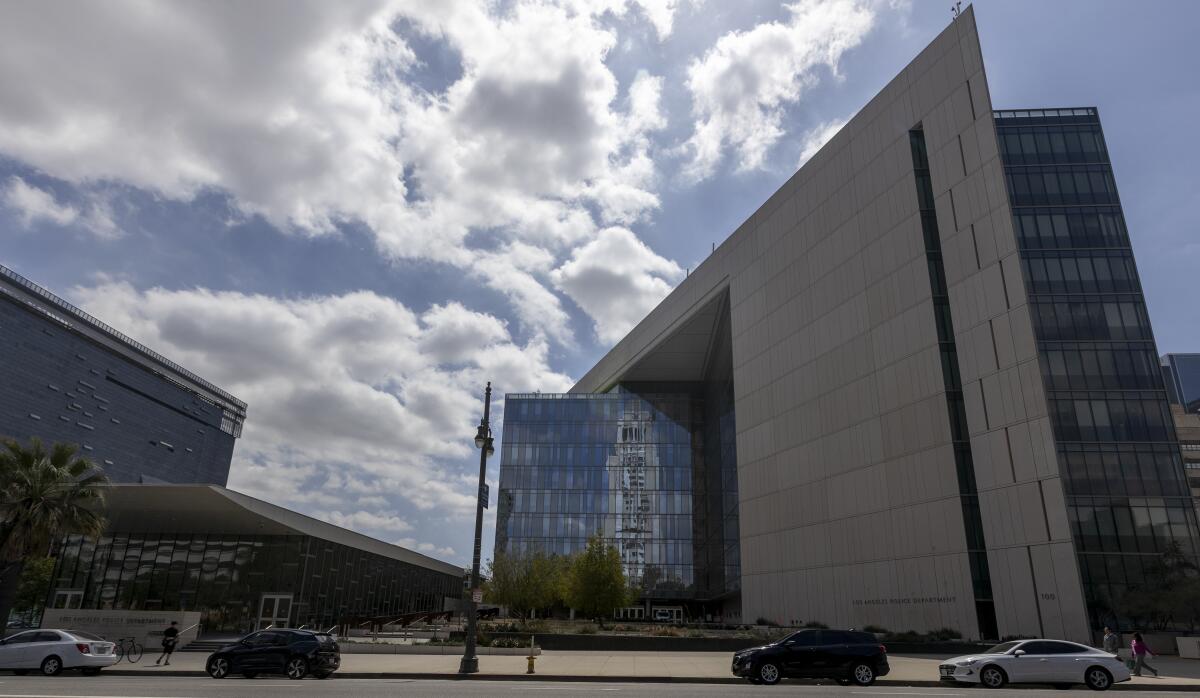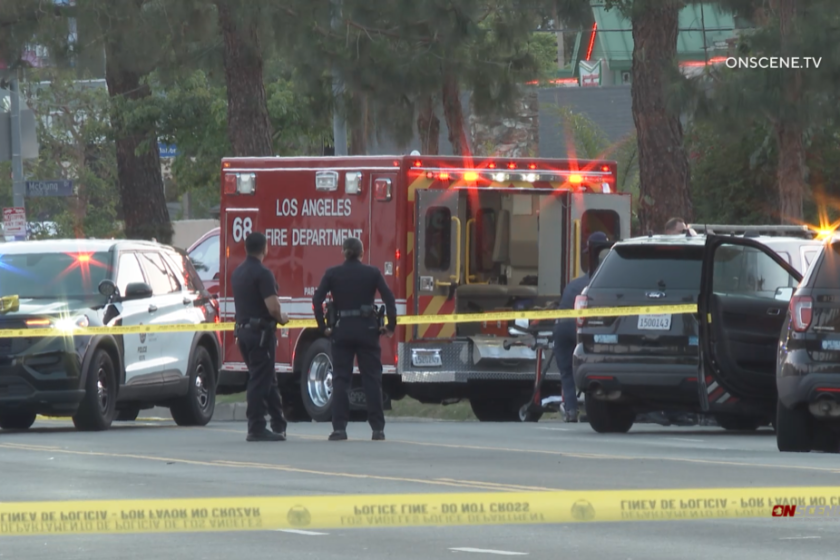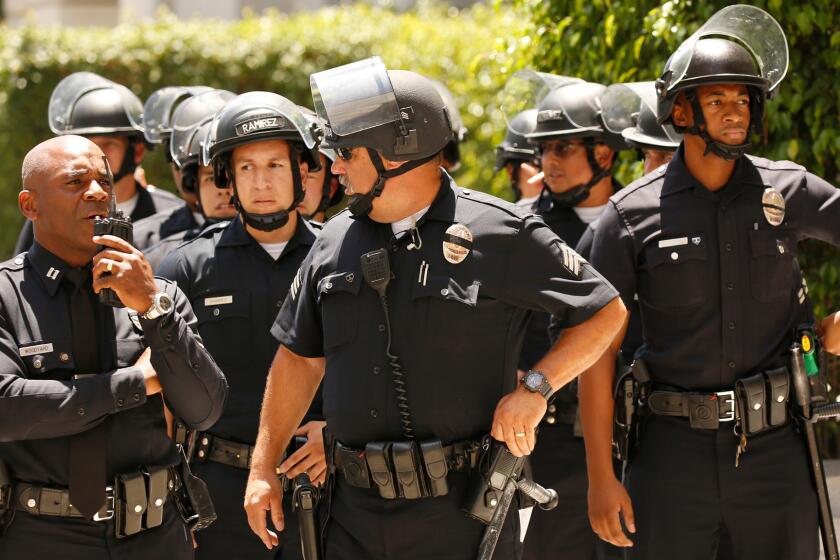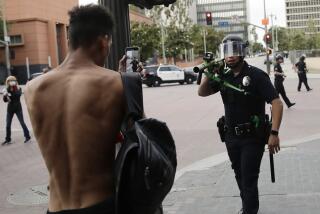They were unarmed when police shot at them. Then LAPD pushed for weapons charges

After Joshua Hatfield fled a traffic stop in late June, a police officer thought the 28-year-old was armed and shot at him outside an apartment building. But no gun was found at the scene.
In the case of Jermaine Petit, officers responding to a report of a man with a gun encountered the 39-year-old walking through Leimert Park. Believing the object in his hand to be a gun, police opened fire. Petit was holding a car part.
After both shootings, Los Angeles police acknowledged neither man had a gun. Yet the department pressed ahead with weapons cases against them: Petit for carrying an imitation firearm and Hatfield on suspicion of assaulting an officer with a deadly weapon.
The district attorney’s office declined to file charges against Hatfield. Police said the case against Petit is pending. An LAPD spokeswoman said last week that she couldn’t comment on either case because both remain under investigation.
The decision to push for charges against Petit and Hatfield has drawn condemnations from neighbors, activists and academics, who see the department’s response as an attempt to deflect scrutiny from its officers’ actions. At least five times this year, LAPD officers have opened fire on people holding something other than a gun or knife: a butane lighter, a car part, a cellphone. In four of those cases, police pursued weapons charges.
Even if the cases are eventually dropped, the LAPD’s decision to pursue charges against the two men is problematic, said Laurie Levenson, a professor at Loyola Law School.
While it might seem reasonable for an officer to mistake an object for a gun during a fast-moving encounter, for the department to insist on charging an apparently unarmed person after the fact could be seen as “trying to defend themselves in the court of public opinion or against any future actions that might come,” she said.
One possible explanation for the charges is that LAPD officials felt that pursuing the cases would provide them with cover, at least in the eyes of the rank-and-file, said Levenson, who is not familiar with the specifics of either incident. A more cynical interpretation, she said, is that police pushed for prosecuting the men in an effort to limit officers’ liability in future lawsuits.
It is not unheard of for the LAPD to submit cases to the district attorney against people who have been shot by officers, particularly in incidents involving individuals with guns who point or fire at police.
But attorney DeWitt Lacy said that, in his years of pursuing civil rights cases, he has often come up against the practice by law enforcement agencies of trying to vilify and discredit victims of police violence to justify the use of force.
At the same time, he added, officers who use deadly force sometimes escape scrutiny that suspects face, “particularly when they’re poor and Black and there’s any type of criminal activity involved in the contact.”
Petit was shot on the evening of July 18 while walking in the area of Martin Luther King Jr. Boulevard and South Bronson Avenue, around the corner from a relative’s house.
Police initially said the man had a “weapon” before retracting that statement, saying a metal latch actuator was recovered from the scene.
At a news conference later that night, an LAPD spokesman said Petit was carrying a “weapon” when police responded to a call about a man with a gun. At a Police Commission meeting the next day, LAPD Chief Michel Moore clarified that Petit was carrying an auto part known as a “latch actuator.”
The case has received widespread attention on social media, where commenters have questioned how officers could mistake the actuator for a weapon and why police were slow to acknowledge that Petit was not armed.
That frustration came to a boil at a virtual community meeting on July 28, which was cut short after audience members called out a police captain who referred to the actuator as a “nonfunctioning firearm,” according to a report by the news site StreetsBlog LA.
In an interview, LAPD spokeswoman Capt. Kelly Muniz clarified that the meeting was intended as briefing, and not a Q&A session. Because of an ongoing internal investigation, she said, police were limited in what they could say publicly. Regarding the department’s inconsistent messaging about the incident, she said, “the bottom line is that whatever goes into that news release [after Petit’s shooting] is the department’s stance.”
“We’ve acknowledged that is not a firearm,” Muniz said of the auto part. “We cannot say what the officers perceived it as. ... It is true that it is not uncommon for suspects to be armed, and, in the process of evading police, they’re able to dispose of or hide a weapon that we can’t find.”
Muniz said the comments made to reporters the night of the shooting were based on preliminary information provided by officers at the scene and that the department releases new information as it becomes aware of it.
Pastor Eddie Anderson said such episodes continue to undermine public confidence in the department and call into question — in his mind — how much law enforcement has really changed since the murder of George Floyd in 2020.
“We’ve changed the laws or tried to change the laws around excessive force,” said Anderson, who is affiliated with McCarty Memorial Christian Church in West Adams. “It’s just another case in point where officers shoot first and then ask questions later.”
That, he said, “makes them more of a threat to the community than a safety net.”
Petit remains in critical condition at a hospital, his relatives have said in news interviews. Attempts to reach his daughter through a GoFundMe page started to cover his medical expenses were unsuccessful.
Alixx Robin Lucas, who lives near the shooting scene, said the incident jolted the Leimert Park neighborhood, long considered a cultural hub for Black culture and a bastion of anti-police-violence activism.
“People are angry, they’re upset, but they’re also, I think, unsurprised,” said Lucas, who saw the aftermath of the shooting. “And that’s probably the saddest part of it all, it’s like, ‘Oh again.’”
As in Petit’s case, a police investigation found that Hatfield was not armed when an officer opened fire on him June 23.
According to video of Hatfield’s shooting released last week, officers pulled him over for allegedly speeding near Crenshaw Boulevard and 39th Street. The officers then ordered Hatfield to lower his car windows. Instead, he drove off, according to dashboard and body camera video posted to the LAPD’s YouTube channel July 28.
The two LAPD officers were identified as Justin Freund and Jennifer Alvarez.
Freund and Alvarez didn’t chase the fleeing car. They found it after about two minutes of driving around. It was parked in the driveway of an apartment building a short distance away, police said.
Another video, from Alvarez’s body camera, showed the officers pulling up to the driveway. Freund is seen running toward Hatfield, who’s standing between several parked cars. Freund demanded Hatfield put his hands up. Then he fired two rounds in Hatfield’s direction, missing him both times.
Alvarez is heard in the footage telling her partner to “chill, chill, chill” immediately after the shots.
She then radioed for backup, telling the dispatcher that police were engaged with a “man with a gun.” In the meantime, Hatfield ran into one of the apartment units.
A police negotiator responded to the scene and could be heard in one of the videos trying to convince Hatfield to surrender with his hands up, telling him, “We’re not going anywhere.”
After about nine minutes, Hatfield emerged and lay on the ground while officers converged on him. As they trained their guns on him and barked orders, he is heard yelling: “Y’all shot at me. I ain’t got sh—, I ain’t got sh—, sir. I ain’t got nothing.”
“I haven’t did anything,” he said, over and over. “I don’t got nothing.”
Hatfield was booked on suspicion of assault with a deadly weapon on a police officer. But the Los Angeles County district attorney’s office declined the case, citing a “lack of sufficient evidence” in a charge evaluation sheet released last week.
The report, dated June 27, points to some confusion in the moments leading up to the shooting. Alvarez told investigators that she believed Hatfield was armed and had fired at police, while Freund reportedly only believed Hatfield had flashed a gun.
The only bullet casings recovered at the scene were from Freund’s department-issued firearm, the report said. Police said they didn’t recover any weapons in the driveway and after obtaining search warrants, “no gun was located in [Hatfield’s] apartment, car, or path of travel,” according to the report.
Hatfield declined to comment for this story.
In a similar case, 45-year-old Jose Barrera was shot by police in March while walking in the area of Martin Luther King and Avalon boulevards. Police had been summoned to the scene by a report of a man who’d pointed a gun at a motorist.
Officers fired at Barrera, believing he was armed. Later, they determined that the black object in his hand was a cellphone. As with the other two incidents, LAPD presented assault with a deadly weapon charges to prosecutors, who declined the case.
After reaching a 30-year low in 2019, the number of police shootings increased each of the last two years.
Fatal shootings by L.A. police officers declined for the fourth year in a row, according to a new report on police use of force.
So far this year, LAPD officers have opened fire 22 times, killing 10 people in the past seven months. That is roughly equal to the number of shootings during the same period in 2021. But it is a substantial increase from 2020, when there were 27 shootings all year, seven fatal.
In response to last year’s increase, Moore pledged a “deep dive” into the department’s training on the use of lethal force to assess whether it properly outlines existing department policies, which have gotten stricter in recent years.
Yet, critics argue that the department hasn’t done nearly enough to end police shootings. Instead of increasing its budget, they say, some of the funding should be diverted to social services that would better serve the homeless population and those grappling with mental illness and substance use issues.
More to Read
Sign up for Essential California
The most important California stories and recommendations in your inbox every morning.
You may occasionally receive promotional content from the Los Angeles Times.













